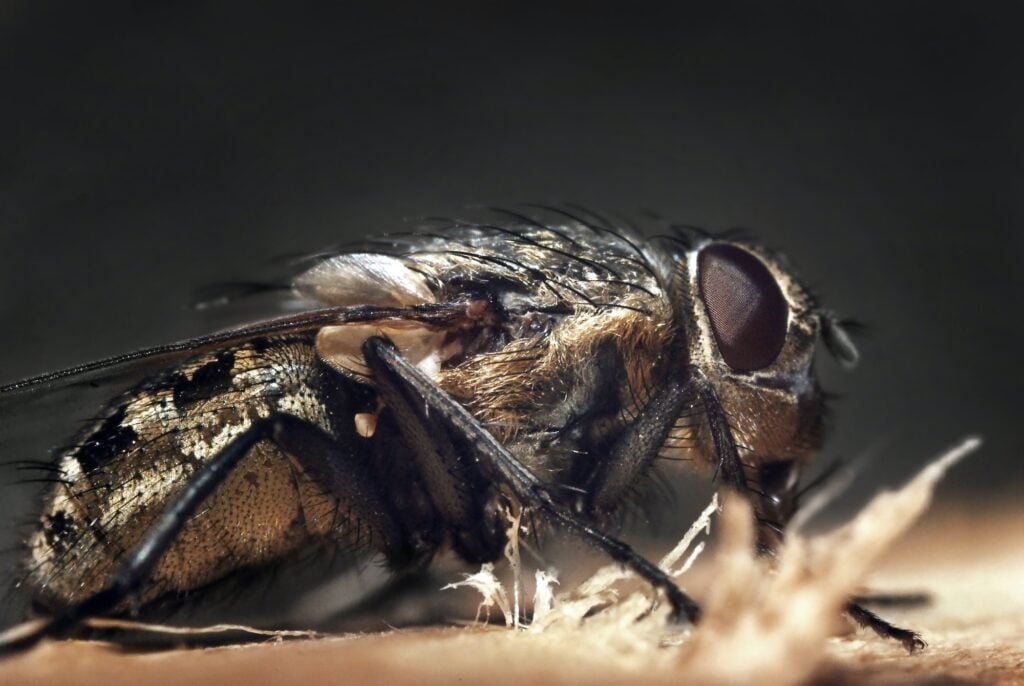

Hey there, fellow dog lovers! When it comes to our furry pals, we all want to keep ’em safe and sound, right? Here’s the scoop: if you’ve ever seen a pesky little mark on your dog and thought, “Is that a Black Fly vs Tick Bite on Dog?”, you’re not alone. It’s a big deal, folks. Making the right call between these two can make all the difference for your four-legged buddy. Now, if you’re thinking, “Why the fuss?”, lemme break it down. Distinguishing between a black fly bite and a tick bite isn’t just about avoiding an itchy situation—it’s about ensuring our dogs stay healthy and happy. And I know what’s up, that’s top priority for every American dog parent. So, if you’ve ever been caught in this bug-biting dilemma, buckle up. We’re diving deep into the nitty-gritty, answering the burning questions, and gearing you up with knowledge every dog owner oughta have. Ready to be the hero your dog thinks you are? Let’s roll!
Recognizing the Culprits
Alright, folks, let’s put on our detective hats. When it’s a showdown between Black Fly vs Tick Bite on Dog, pinpointing the culprit behind your furbaby’s unease is key to giving those pests the boot. Let’s dive deep into the prime suspects.
Black Flies: The Itchy Menace
You know the saying, “Don’t sweat the small stuff”? Well, when it comes to black flies, that’s easier said than done. These tiny buggers are about as big as a grain of rice, usually sporting a dark hue. Their wings are clear, and their bites? Oh, boy – let’s just say they’re the kings of itch-central. If your doggo’s been romping around near water sources like rivers or lakes, especially during the warmer months, you might have black flies to blame. Yep, these little pests love the wet areas of the USA, from the charming creeks of the Midwest to the scenic waterways of the East Coast. They may be small, but, trust me, you’ll know if they’ve paid a visit.
Ticks: The Stealthy Parasite
Ticks, on the other hand, are a whole different ball game. These arachnids (yeah, they’re cousins to spiders, ew!) vary in size, from tiny specks to as big as a pencil eraser, especially when they’ve had a good feed. Sporting colors from brown to reddish-brown, they love hitching a ride on our fur-babies, attaching themselves firmly to the skin, and feasting away. Most American backyards can harbor ticks, especially those with taller grass or nearby woods. If your pup’s favorite hangout spots are wooded areas, shaded places, or tall grassy regions, then staying tick-aware is the name of the game.
Now that we’ve put on our investigative caps and got the 411 on these pests, we’re better prepped to spot ’em and stop ’em. But identifying the culprits is just the beginning. To truly tackle the issue head-on, understanding the aftermath of their pesky bites is crucial. So, let’s move on and dive into the nitty-gritty differences between these bites.
Comparing the Bites: Side-by-Side
When it comes to your furry BFF, ain’t nobody got time for nasty bites. So, let’s get down to brass tacks and suss out the telltale signs of each culprit’s handiwork (or should I say, ‘mouthwork’?).
The appearance of Black Fly Bites on Dogs


Black fly bites ain’t no joke. These pesky nibbles often show up as a swollen, red spot that can look pretty darn angry. It’s like Mother Nature’s version of a bad Yelp review, right on your pup’s skin. These bites can also be particularly itchy, and if your fur-baby can’t resist scratching, they might even turn into small, open sores. Here’s the kicker: it ain’t just a “bug bite.” The swelling and redness are due to toxins the fly injects to prevent blood clotting. Sounds like a real piece of work, huh?
What Does a Tick Bite Look Like on a Dog?


Ticks are sneaky little devils. At first, a tick bite might just seem like a small red bump, almost like a pinprick. But give it some time, and things can get dicey. If the tick’s been feasting for a while, it can become engorged and look like a gray or dark lump. And let’s not forget about the dreaded red circle, a potential sign of Lyme disease. If you see that angry red halo, it’s a big ol’ red flag, and you might want to holler at your vet, stat.
Beyond the Bite: Potential Complications
Bites are the gift that, unfortunately, keep on giving. With black fly bites, secondary infections from incessant scratching are a real concern. And with ticks? Oh, honey, it ain’t just Lyme disease. These freeloaders can transmit a whole host of nasties, like anaplasmosis or babesiosis, that can get your pup feeling all kinds of wrong.
Alright, so we’ve painted a pretty clear picture of these uninvited guests and their troublesome bites. But don’t fret; we’ve got your back. Now that we’re armed with this knowledge, let’s move on to the really good stuff: getting rid of these nuisances and making sure they think twice before munching on your mutt.
Effective Treatments and Preventions
Alright, folks, we’ve laid out the nitty-gritty about those pesky parasites. Now, let’s dive into the good stuff: giving those bugs the boot and giving your fur baby some relief.
Black Fly Bite Treatment for Dogs
Let’s face it: seeing your pup in distress is like a punch to the gut. For those dang black fly bites, immediate relief can come from cold compresses. This helps to reduce the swelling and itch. A dab of anti-itch cream or even a dose of antihistamines (always vet-approved, y’all) can be a game changer too. Now, for the long haul: keep those bites clean. This ain’t just about comfort; it’s about preventing infections that can turn a small problem into a big one.
And here’s a golden nugget of wisdom: those routine vet visits? Yeah, they’re more crucial than you might think. Especially when you’re dealing with unnoticed nibbles that could be brewing something more sinister.
Addressing Tick Bites
Ticks are like that uninvited party guest that just won’t take a hint. First off, if you spot one, get that sucker off ASAP. Use fine-tipped tweezers, grab it close to the skin, and pull upward with steady pressure. Once it’s out, clean the area well. Keep an eagle eye out for signs of Lyme disease, like that dreaded red circle. But prevention is the best cure, right? Think tick collars, spot-on treatments, or even oral meds. Chat with your vet to figure out the best game plan for your canine compadre.
General Tips for Keeping Pests at Bay
Ain’t nobody got time for pests, especially when your four-legged buddy is involved. For starters, consider natural repellents like lemon eucalyptus oil. And hey, why not create a safe haven in your yard? Keep the grass short, and clear out any brush or leaf litter. Think of it as creating the ultimate bug-free playground for your pup.
Now that we’ve got a solid game plan in place for dealing with these pesky pests and their aftermath, it’s time to address some burning questions y’all might have. Let’s move on to some FAQs and put those concerns to bed.
FAQs: Addressing Dog Owners’ Concerns
Look, we get it. When it comes to Black Fly vs Tick Bite on Dog, the concern is real. Our furry companions are our world, and even the slightest hint of danger has us on high alert.So, let’s roll up our sleeves and tackle some of those burning questions keeping y’all up at night.
Why are my dog’s bug bites swelling?
Well, ain’t that the million-dollar question? Just like us humans, dogs can have allergic reactions. A swelling bug bite might be your doggo’s body saying, “Hey, I don’t like this!” It’s their immune system kicking into overdrive. But hold up, it’s not just allergies. If you’ve been slacking on keeping that bite clean, infections might be crashin’ the party too.
How do I know if my dog has Lyme disease?
You ever heard of the “bull’s-eye rash”? It’s a bright red circle, kind of like a target. That’s a telltale sign, my friend. But remember, our furry pals might also show symptoms like fever, limping, or just seeming downright out of it. When in doubt, ring up your vet.
How often should I check my dog for bites?
Alright, here’s the skinny: If your pupper’s been out romping in the woods or tall grass, you’ll wanna give ’em a good once-over when they’re back inside. Think of it as a post-adventure ritual. Regular checks aren’t just for peace of mind; they can be lifesavers.
Can I use human repellents on my dog?
Hold your horses! While we might be tempted to share everything with our fur babies, some human repellents can be toxic to them. DEET, for instance? Big no-no. If you’re lookin’ to keep those bugs at bay, scout out products made explicitly for dogs.
What should I do if I can’t remove the entire tick?
First off, don’t hit the panic button. Sometimes, the mouthparts of the tick remain embedded in the skin. Clean the area, keep an eye out for any signs of infection, and give your vet a shout. They might have some tips or want to take a gander themselves.
There ya have it, folks. With knowledge in your arsenal, those pesky bugs won’t stand a chance against you and your pup. Ready to wrap this up? Let’s move on and tie up all the loose ends.
Conclusion: Black Fly vs Tick Bite on Dog
Alrighty then, let’s bring it home, folks.
Steering through the maze of Black Fly vs Tick Bite on Dog can feel like navigating a minefield, especially when our furry kin are the prime targets. From the sneaky black flies to those darn ticks hiding in the grass, we’ve dived deep into what each bite looks like, the aftermath, and how to keep our dogs safe and sound.
And hey, let’s not beat around the bush here: early intervention is the name of the game. Whether it’s a harmless itch or a warning sign of something more sinister, catching it in the nick of time can save a lot of heartaches. As they say, better safe than sorry, right?
For all you dog lovers out there, know that your concerns are seen, heard, and felt. We’re in this together, after all. Our furry friends mean the world to us, and the lengths we go to ensure their safety. Well, that’s just a testament to the unbreakable bond we share. So, here’s to every tail wag, every sloppy kiss, and every midnight bark. Keep looking out for them, and they’ll return the love tenfold.
Signing off, and remember: love them, protect them, and always keep an eye out. Because in this dog-eat-dog world, our pups deserve nothing but the best. Peace out, y’all. Stay safe and keep those tails waggin’.


















[…] Black Fly vs Tick Bite on Dog: What Every Owner Must… […]